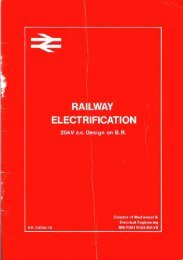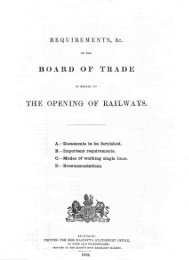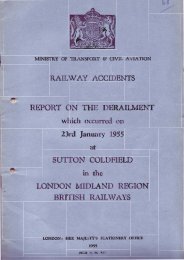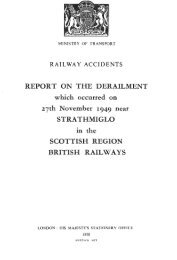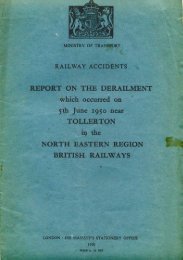R A I LT R AC K - The Railways Archive
R A I LT R AC K - The Railways Archive
R A I LT R AC K - The Railways Archive
You also want an ePaper? Increase the reach of your titles
YUMPU automatically turns print PDFs into web optimized ePapers that Google loves.
4.4<br />
4.4 Renewals policy<br />
We have worked hard in the past year to target our<br />
renewals expenditure on those assets and locations that will<br />
have the greatest positive impact on train performance –<br />
eliminating temporary speed restrictions, raising track quality,<br />
and reducing the number of broken rails.<br />
Our work has identified improved asset-management<br />
regimes for most of our major assets.We have identified<br />
opportunities to inspect and maintain assets more effectively<br />
so that we can target subsystem renewals,with the result<br />
that complete asset renewal is required less often.We have<br />
also developed techniques to enable us to target renewals at<br />
those 200 or so critical locations that have the greatest<br />
impact on train performance .<br />
In all cases we will renew assets with the most<br />
appropriate, contemporary equipment available that<br />
minimises whole-life costs and minimises the disruption<br />
caused by installing the equipment.<br />
We continue to work with suppliers to ensure that the<br />
work they plan reflects these priorities,so that the benefits<br />
for passengers are captured.<br />
We also continue to develop further measures to<br />
enable us to identify the condition of each asset,the impact<br />
of inspection,maintenance and renewal options on asset<br />
condition,and the end impact of that condition on the<br />
journey experience by passengers.This work is reflected in<br />
the new measures of the output of our signalling and<br />
electrification assets included in this NMS.We have not<br />
made the progress we had hoped on developing detailed<br />
systems for measuring asset condition due to the resources<br />
required by the Year 2000 project.<br />
Track renewals. We have developed track asset-<br />
management processes to help us target track renewals at<br />
those locations where they will have the most impact on the<br />
quality of the track and on train-running performance.We<br />
assess potential sites for track renewals against financial and<br />
asset-condition criteria to ensure that the optimum decision<br />
is made between continued maintenance and partial or<br />
complete renewal.<br />
Renewals specifications reflect current best practice and<br />
normally use continuous welded rail on concrete, steel or<br />
hardwood sleepers.This provides greater reliability and the<br />
ability to carry heavy axle-weight vehicles,while reducing<br />
disturbance from the effects of noise and reducing the<br />
maintenance requirements compared with older track<br />
comprising jointed rail and softwood sleepers.Where<br />
reballasting is carried out, we ensure that any underlying<br />
drainage or formation problems are dealt with to provide a<br />
long-life and low-maintenance track structure . Renewals of<br />
switches and crossings are now carried out in fully welded<br />
form,and we have introduced some modern continental<br />
practices giving improved ride quality, reliability and reduced<br />
maintenance.<br />
We are working with our suppliers to ensure that we<br />
gain the benefits of stoneblower, on-track flash-butt welding<br />
and high-output renewal technologies. We have also<br />
improved the efficiency of our engineering materials haulage<br />
and ballast delivery process to improve its efficiency.<strong>The</strong>se<br />
improve the economics of track asset management.<br />
Planned renewal volumes reflect our current<br />
understanding of future traffic volumes and flows.Significant<br />
increases in volumes or shifts in flows will affect the track<br />
renewals required for optimum asset management.<br />
We are continually looking at developments in track<br />
management and are partners in various European research<br />
projects to improve track asset performance .<br />
Structures renewals. Structures are identified for<br />
renewal where maintenance of the network operation is<br />
impracticable for technical or economic reasons.<br />
Given the diversity of structures owned by Railtrack,it<br />
is necessary to appraise the condition of each structure<br />
individually and to define site-specific actions.This means that<br />
the renewal activity performed on two structures which are<br />
s u p e r fi c i a l ly similar can differ in scale and scope. C o n s e q u e n t ly,<br />
it is not easy to identify specific trends in the nature of<br />
materials used and the technologies applied.<br />
To ensure that renewals evaluation is both rigorous and<br />
consistent, we have developed new asset condition<br />
modelling techniques for our masonry and metallic bridge<br />
stock.Effectiveness of our renewals investment will continue<br />
to improve as this approach is applied to renewal decisions<br />
during 1999.<br />
One consequence of this process is that renewals<br />
activity on heavily loaded lines will be more extensive and<br />
will have a longer design life than that on lightly loaded lines,<br />
where piecemeal activity is often more cost-effective. Other<br />
structural types will be subject to this process during 1999.<br />
We have developed<br />
techniques to enable<br />
us to target renewals<br />
at those 200 or so<br />
critical locations that<br />
have the greatest<br />
impact on train<br />
performance<br />
37



